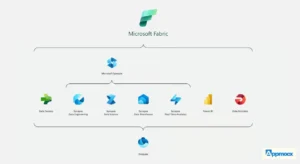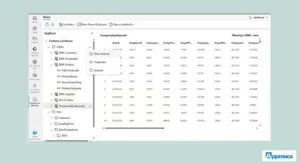What is Microsoft Fabric?
Microsoft Fabric is a versatile analytics platform created for enterprises and data experts that simplifies tasks such, as data analysis and real time analytics along with data storage and transfer by bringing a variety of tools and technologies in a manner for a smooth user experience.
Fabrics primary goal is to make data tasks easier, by bringing together information from places into one system for organizations to work with effortlessly and efficiently without getting bogged down by intricate technical details. This simplified method lets data experts focus on delivering outcomes of grappling with complicated tools and processes. Moreover, it removes the hassle of data teams having to invest time deciphering the intricacies of licensing agreements, between Synapse, Azure Data Factory and Power BI for integration.
Microsoft Fabric Features
The Microsoft team has identified five areas that set Fabric apart from other offerings in the market:

#1 Top Analytics Platform for Comprehensive Insights
Each analysis project requires a range of systems, with needs to function smoothly and efficiently. These systems frequently rely on information from suppliers which can complicate the integration process and lead to expensive outcomes.
This is where Microsoft Fabric stands out.
Microsoft Fabric makes it easier by providing teams with a solution that has an user interface and a streamlined architecture along with a full set of tools.This allows for smooth data extraction and analysis, to present insights effectively.
#2 Lake-focused and expansive
Creating data lakes can be quite a mess, with their chaos and intricacy making it quite a challenge to build them up and manage them smoothly Integration can become a headache too once the data lake is up and running due to problems like data duplication and being locked in by vendors This is mainly because various data products are used each with their unique formats, within the same setting.
Fabric tackles these obstacles using OneLake. A SaaS powered data lake that spans cloud platforms seamlessly integrated with Microsoft 365 integration and Microsoft 365 applications and Fabric’s suite of workloads.
Teams using OneLake can get rid of scattered data silos caused by individuals creating storage accounts on their a common issue that creates fragmentation in data management systems and makes sharing information within the organization a hassle.
#3 Artificial intelligence
Microsofts Azure includes the OpenAI service that is fully integrated into Microsoft Fabric across all levels to help users make the most of their data effectively and efficiently. This integration enables developers to leverage the power of AI to extract insights, from customer data, for business purposes.
By having Copilot integrated into all Microsoft Fabric data experiences allows users to use natural language interactions effectively:
- Develop dataflows and data pipelines
- Build machine learning models
- Visualize results
- Generate code and entire functions
Users can create their conversational language interactions by connecting their information with Azure OpenAI integration and Service models and sharing them as plugins.
#4 Enabling all business users with confidence
Many companies aim to foster a culture that values using data to guide decision making for all employees. Microsoft Fabric plays a role in this effort by providing access, to analytics for everyone. By integrating with Microsoft 365 applications, Fabric turns these tools into main platforms, for uncovering and using important insights.
#5 Lowering costs with integrated capabilities
When vendors products are combined in one project this often leads to inefficiency due, to the need for separate computing resources for different systems, like data engineering or business intelligence which results in wasted capacity when one system is idle and unable to be utilized by others.
Fabric tackles this problem by making it easier to obtain and oversee resources effectively. Like a one stop shop, for power that caters to tasks such as data integration and data science among others. This holistic method aids in cost reduction since any surplus compute capacity can be reallocated to support tasks in need of it.
OneLake: The Core of Fabric
Microsoft Fabrics foundation lies in OneLake—a central storage system that stores all the data used in Fabric operations seamlessly and efficiently.
OneLake is frequently likened to OneDrive in comparisons made by Microsoft where they state that while Office stores Word documents and spreadsheets, in OneDrive; Fabric houses lakehouses and warehouses in OneLake which has led to the perception of OneLake as a platform to OneDrive but, for data storage purposes.
Prior, to the advent of OneLake in the scene of data management within organizations was characterized by the creation of data lakes tailored for teams which posed challenges, for collaboration and demanded additional resources to manage effectively OneLake was developed to address these challenges by dismantling data silos encouraging enhanced teamwork and streamlining the handling of organizational data.

The key features:
Shortcuts
The feature called a shortcut permits allows users to blend data from business divisions and areas into their virtual data offering. This allows companies to effortlessly exchange information, between users and programs without having to copy or move it, the concept of “shortcut” pertains to data kept in alternate file destinations whether within the same workspace or spanning different ones Irrespective of where it is physically situated the shortcut indicator creates the illusion that files and folders are stored locally.
Openness
Microsofts Azure Data Lake Storage (ADLS) Gen 2 is a data analytics tool that leverages Azure Blob Storage, for enhanced data management capabilities and flexibility in handling both structured and unstructured data types—making it a valuable component within the OneLake platform due to its commitment to openness and ease of access, across all operations.
Additionally, OneLake easily connects with ADLS Gen 2 applications such as Azure Databricks by using the APIs and SDKs. Users do not require knowledge in Microsoft Fabric to reach the core data. Instead they can engage with OneLake similarly to an ADLS storage account that caters, to the company.
One copy of data
OneLake eliminates the requirement to duplicate data, for uses or dismantle silos to carry out integrated analysis – a problem that no longer exists with OneLake as per its documentation stating that “OneLake aims to optimize the worth of a data copy without the need for data relocation or replication.”
Governance by default
One of the benefits of SaaS services is the idea of tenants. Groups of customers that have shared access and specific permissions within a software instance as explained in the OneLake documentation: “Defining the boundaries of a customers organization ensures governance and compliance are well managed by the tenant administrator.” Essentially speaking all information saved in OneLake is automatically regulated as a practice.
Fabric Workloads and User Interactions
Microsoft Fabric provides workloads tailored for specific user profiles to enhance the platform experience, for each individual user through seamless integration with OneLake.
Some important tasks to focus on are:
Data factory
The Data Factory offers more than 150 connectors for cloud and on premise data sources to help with data pipeline management and provides a user friendly interface for smooth data transformation, through drag and drop functionality.
Synapse data engineering
The data engineering tasks in Fabric come with some features, like Lakehouse technology which offers a workspace for users to work in a collaborative environment supported by the Spark engine provided by Microsoft for an enhanced authorship experience and quick startup options using live pools.
Synapse real-time analytics
Developers can use real time analytics to stream data from Internet of Things (IoT) devices and various sources, like telemetry and logs using the Kusto Query Language (KQL). This allows for analysis of amounts of semi formatted data with minimal delays in performance.
Synapse data warehouse
The data warehouse workload provides data engineers and analysts with an integration of Lakehouse and data warehouse features.The driving force, behind this service is a state of the art serverless SQL engine that is specifically designed for performance and integration using data formats.
Synapse data science
Users are supported by the Data Science workload to guide them through the data science process from start to finish effectively and efficiently by equipping data scientists with a variety of tools, for creating sophisticated AI models and working together on projects while also streamlining the training deployment and management of machine learning models.
Data Activator
Data Activator is a tool on Microsoft Fabric that’s easy to use and doesn’t require coding knowledge. Its purpose is to initiate actions in response to identified patterns or certain conditions found in real time data.
Business Intelligence (Power BI)
Fabrics business intelligence capabilities are rooted in the use of Microsofts analytics platform called Power BI powered by intelligence technology This tool enables business analysts and other users to discover insights, from their companys data Additionally it smoothly integrates with Microsoft 365 giving users access to relevant data insights, across various 365 applications
Conclusion
Microsoft Fabric is a cutting edge platform that brings together tools and services to create a streamlined solution.
OneLake and its varied tasks are components that empower businesses and data experts to make decisions based on data insights effectively.Those familiar, with data science or business analysis looking to leverage datas power can rely on Microsoft Fabric, for an integrated approach that simplifies data operations.
The integration, in Microsoft Fabric that truly stands out is with Power BI – Microsofts top notch analytics service! If you’re keen, on delving into data analysis and visualization tools for those looking to upskill in Power BI Fundamentals – our specialized training pathway is an option! This program will empower you with the skills needed to convert data into insights effectively aligning with the functionalities of Microsoft Fabric.